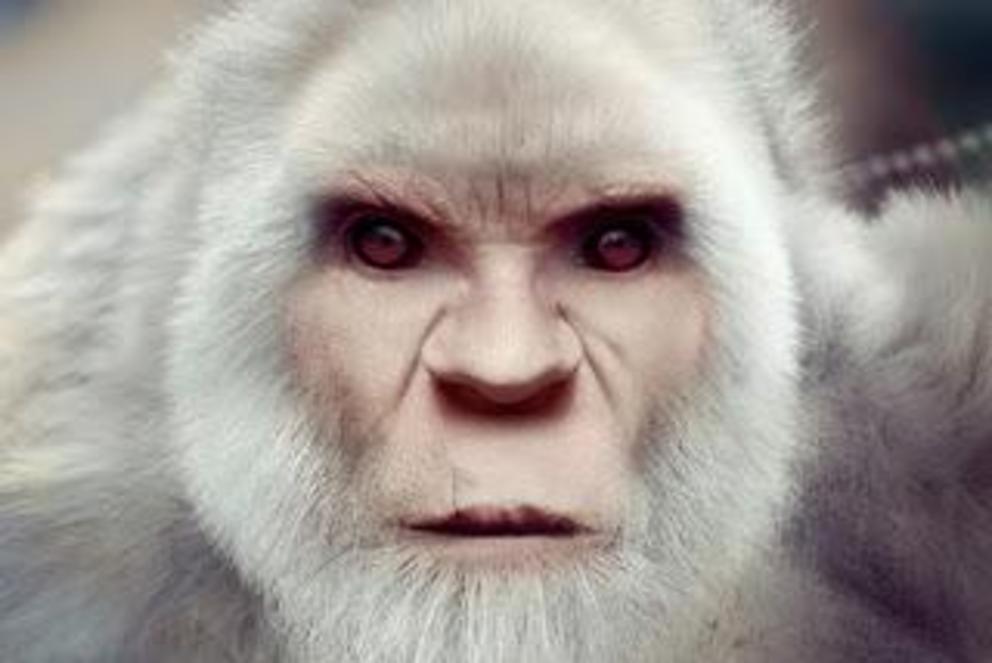What makes a Bigfoot white?
There are a few theories that are thrown out there by researchers on how some bigfoot or sasquatch are white in color.
One of them is that bigfoot and sasquatch turn white in the winter.
This is true in some animals. There are 7 known animals that will turn white in the winter season.
1. Hares : Among them are the Arctic hare and the Mountain hare.
2. Weasels : The 3 are the least weasel, the long-tailed weasel, and the short-tailed weasel [also known as a stoat or most commonly, ermine].
3. Peary Caribou.
4. Collared lemmings.
5. Ptarmigans : [birds] The white-tailed Ptarmigan turns a total white, white others retain some black feathers in their tails.
6. Siberian hamsters.
7. Arctic foxes.
Scientists conjecture that the seasonal shift in colors may be for camouflage. It is based on evolutionary factors through their development. It is also suggested that the paler colors help with keeping the animal warmer during the cold months.
It is also possible that the color is related to photoperiod, which is the amount of light that is received during the day. During the winter, there is less daylight and the color fades.

Another theory is that the white [or gray] is caused by aging. But there is more than just aging that can cause hair to turn white.
Let's discuss briefly what determines hair color. The color of your hair is a product of two pigments in the hair shaft : eumelanin and phomelanin. The more eumelanin, the darker your hair color. The more phomelanin and the redder your hair.
Blond hair consists of a little bit of eumelanin and little to no phomelanin.
Auburn hair has a lot of eumelanin and some phomelanin.
Red hair is all phomelanin and very little eumelanin.
Hair color is a result of a combination of many genetic factors. Scientists are unclear about how it works.
Natural hair color can change as you get older. Lighter hair can turn darker as you grow up and then start fading again. This is all due to how much of eumelanin and phomelanin is produced in the hair shafts. Your genetics don't change, the hair follicles stop producing the pigment.
As a side note, gray hair is actually an optical illusion. Colored hairs are mixed in white hairs and look gray. If you look closer you can see the different colors. Achromotrichia happens at different rates and times for each person. The pigment doesn't fade, it just "shuts off". And the more white hair you have, the more gray your hair appears to be.
Besides aging, there are other reasons for hair to turn white.
1. There is "premature aging". This is genetic - the hair follicles stop producing color.
2. Vitiligo is an autoimmune disease that can cause this. The immune system can attack hair and cause a loss of pigment.
3. Types of anemia. This will effect the blood.
4. Thyroid disorders can cause the body to produce less melanin resulting in loss of pigment.
5. Stress can cause a depletion of stem cells. No pigment being produced.
6. Vitamin deficiencies can affect the health of hair growth and color. These include B-12, B-6, Vitamins D and E.
7. Smoking can also be a factor. It restricts blood flow to the hair follicles. It can result in hair loss and the stoppage of melanin being produced.
8. Some chemicals that are used in hair dyes and shampoos and other hair products can also stop the production of melanin. Hydrogen peroxide is the most well known.

So, how does all this concern bigfoot and sasquatch?
I believe we can discard the winter camouflage theory. If that were so, either all the reported sightings during the winter months would be of white ones. Or they would be so well camouflaged we would have no sightings at all.
I also discard aging as the only factor in white or gray bigfoot and sasquatch. In my research I have come across young, adult and aged ones who are white or gray. I have also encountered those who do develop gray and/or white hair as they get older.
It is difficult to determine if any of the health factors contribute to the hair color in bigfoot and sasquatch as we have little to no information available to us on their health. This also true with any stress factors. We have little to no idea if they are stressed and if being stressed they might lose melanin in their hair.
I believe we can most likely eliminate the smoking factor. I have yet to see one light up a cigarette, although some people report that some bigfoot and sasquatch will accept tobacco as a gift. Few report back on the uses that bigfoot and sasquatch make of the gift.
I also think we can discard the use of damaging chemicals in hair products as a cause for white hair.
Another theory is albinism. This condition is a congenital defect that prevents color pigment from reaching the skin, hair and eyes. This is passed down through either parent. There is no melanin present. The subject has pinkish or pale blue eyes. This condition can sometimes have hearing and/or visual problems.
Leucism is a partial lack of pigment which will produce a pale almost blonde color. There are a few reports out there of blonde bigfoot being seen; along with reddish, light tan, strawberry blonde, among other lighter shades.
I tend to think that white and grey bigfoot and sasquatches are a natural coloring for them. Some white and grey highlighting can be attributed to the aging process. This I have seen on heads, faces, and chest area. Albinism may account for some the sightings but not all of those closer sightings claim that the bigfoot or sasquatch had pink[red] or blue eyes.
